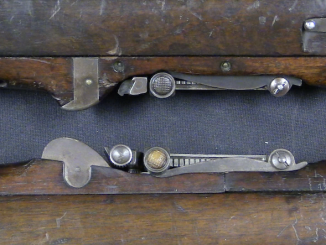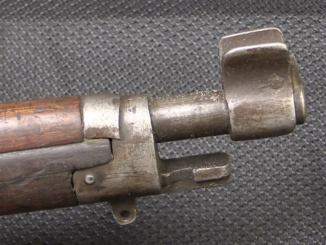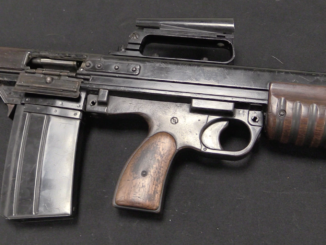The Thorneycroft was the first military bullpup rifle, developed in the United Kingdom in response to combat experiences in the second Boer War showing the British infantry rifles to be overly long and cumbersome. Scotsman James Baird Thorneycroft figured he could address this by moving the action and magazine of a rifle behind the trigger, thus shortening the overall length without reducing the barrel length – the bullpup concept. He was able to produce a series of prototype rifles using this concept beginning in 1901, which were tested by the British military. Thorneycroft’s rifle was chambered for the standard .303 British cartridge, with a 5-round magazine (no provision for charger clip use), and had a nice aperture rear sight and cock-on-open two lug bolt. While it was about 10% lighter than the standard long Lee rifle and about 7.5 inches shorter, the British military turned down his idea, instead adopting a universal short rifle for the cavalry and infantry both to use.
Armament Research Services (ARES) is a specialist technical intelligence consultancy, offering expertise and analysis to a range of government and non-government entities in the arms and munitions field. For detailed photos of this Thorneycroft, don’t miss the ARES companion blog post!




Video fail! And no wonder the gun was rejected, it can’t load quickly! Why not develop magazines further to circumvent the problem? Oh, wait, conservatives don’t like that.
Linkage?
Brilliant! Thank you very much!
I’d long been fascinated by this and other bolt-action bull-pup rifles.
I daresay that had the stock comb/cheek piece been made solid, with an internal tunnel cut away for the reciprocation of the bolt, it could have been made so that it could be entirely operated from the shoulder without having to move the cheek weld…
Good observations on the magazine to move the cartridges back and prevent the rims from interlocking… Took a while for the UK to adopt the rimless pattern what with all of the World Wars and so on…
Very intriguing examination of a truly “Forgotten Weapon”!
“other bolt-action bull-pup rifles”
For 1990s/2000s bolt-action bull-pup rifle see:
http://modernfirearms.net/en/sniper-rifles/large-caliber-rifles/russia-large-caliber-rifles/ksvk-12-7mm-eng/
For 1990s/2000s bolt-action bull-pup rifle see also:
http://modernfirearms.net/en/sniper-rifles/vm-2000-2/
For 1990s bolt-action bull-pup rifle see:
http://www.sinopa.ee/sor/bo001/bo05sv/bo05sv23/svn98.htm
Due to meanders of U.S. taxonomy I do not know if it is bolt-action or not bolt-action, so see and decided if it is or is not:
http://guns.wikia.com/wiki/OTs-44
Now bull-pup bolt-action from Czech Republic:
http://modernfirearms.net/en/sniper-rifles/large-caliber-rifles/czech-republic-large-caliber-rifles/falcon-eng/
That Falcon rifle in 50 BMG or 12.7 Russian is matter of past. The factory producing them (Zbrojovka Vsetin) had been closed for some time by now. They were involved mostly with aircraft armament, which comes (for those couple of Grippens) from abroad.
Long range rifles for ACR were purchased last time from Desert-Tech Utah, by coincidence also bullpup.
“Took a while for the UK to adopt the rimless pattern what with all of the World Wars and so on…”
Actually Great Britain’s send rimless cartridge for troop trial yet before Great War, see: https://sites.google.com/site/britmilammo/-256-276-inch
Finally Ian is wearing some white gloves with a collectable specimen.
Ian addressed that in a Q&A once. He leaves it up to the owner as to whether or not he wears gloves.
Again, a testimony that there were some really clever and inventive people in past in firearms. Excellent presentation!
It looks like a SMLE that got messed up in the Transporter beam.
Sorry.
I read years ago, probably in the, alas now defunct, British “Guns Review” magazine that it was mainly the Swiss who made a lot of the development of the .303 for the British in the late 1880’s. The early types were apparently a straight tapered design with the bullet held in the case mouth by a collar. It apparently started out as a rimless design but the British insisted on a rimmed version as they felt that it would be more reliable when used in belt fed machineguns.
Gwyn
Given how the Maxim gun works, the rim makes sense. It’s easy to hold a rimmed round in a cloth belt and it could make loading the belt easy if done by hand. Belt loading devices may prefer rimless cartridges. Did I mess up?
“Given how the Maxim gun works, the rim makes sense.”
Maxim gun can be done to work with rimmed or rimless cartridge, see for example MG 11 (Switzerland).
“it could make loading the belt easy if done by hand”
Depend on belt, manual loading of belt for PK is not easy task.
“Belt loading devices may prefer rimless cartridges”
Dubious, Rakov gadget as used for PK belt is well liked.
I suspect that possible choice of rimmed design was done, because manufacturing technology for such cases was already well understand. Also, possibly with then used technology rimmed might be cheaper to produce that rimless, not by much, but if you multiply by quantity of cartridges…
The rifle in this video is a late model Thorneycroft-Farquhar rifle developed in 1905 in collaboration with Moubray Gore Farquhar. The original 1901 model looked quite a bit different. There was also a later 1906 model developed in tangent with Arthur Henry Hill, which was similarly unsuccessful. Hill and Farquhar went on to develop the Farquhar-Hill rifle together, while Thorneycroft retired.
James Baird Thorneycroft was the deputy Lord-Lieutenant of Ayrshire and lived from 1851 to 1918.